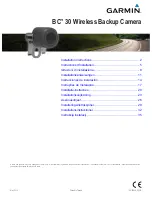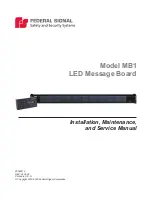
Usage Precautions
Notes on cable configurations
The presence of lighting equipment and television receivers nearby may result in
video noise. In such cases, change the cable configurations or placement.
Notes on LAN cable connection
Secure the locking screws on the connector manually,
and do not use a driver. Do not secure the screws too
tightly. Doing so may wear down the screw threads
on the camera. (Tightening torque: 0.147 Nm or less)
Notes on attaching the lens
Avoiding dust particles
When attaching the lens to the camera, stray dust and other particles may adhere
to the sensor surface and rear surface of the lens. Be careful of the following
when attaching the lens.
• Work in a clean environment.
• Do not remove the caps from the camera and lens until immediately before
you attach the lens.
• To prevent dust from adhering to surfaces, point the camera and lens
downward and do not allow the lens surface to come into contact with your
hands or other objects.
• Always use a blower brush to remove any dust that adheres.
Never use your hands or cloth, blow with your mouth, or use other methods to
remove dust.
Phenomena specific to CMOS image sensors
The following phenomena are known to occur on cameras equipped with CMOS
image sensors. These do not indicate malfunctions.
• Aliasing
When shooting straight lines, stripes, and similar patterns, vertical aliasing
(zigzag distortion) may appear on the monitor.
• Blooming
When strong light enters the camera, some pixels on the CMOS image sensor
may receive much more light than they are designed to hold, causing the
accumulated signal charge to overflow into surrounding pixels.This
“blooming” phenomenon can be seen in the image, but does not affect the
operation of the camera.
• Fixed pattern noise
When shooting dark objects in high-temperature conditions, fixed pattern noise
may occur throughout the entire video monitor screen.
• Defective pixels
Defective pixels (white and black pixels) of the CMOS image sensor are
minimized at the factory according to shipping standards. However, as this
phenomenon can be affected by the ambient temperature, camera settings
(e.g., high sensitivity and long exposure), and other factors, be sure to operate
within
the camera’s specified operating environment
.
Notes on exportation
When exporting this product, please follow the export regulations of your country
or region.
Secure manually.
Do not secure too tightly.
Go-X Series GigE Vision I/F
— 6 —
Содержание Go-X Series
Страница 79: ...Go X Series GigE Vision I F Spectral Response GOX 2402MC PGE 79 ...
Страница 80: ... 80 Spectral Response GOX 3201MC PGE Go X Series GigE Vision I F ...
Страница 81: ... 81 Spectral Response GOX 5103MC PGE Go X Series GigE Vision I F ...
Страница 82: ...Go X Series GigE Vision I F Spectral Response GOX 8901MC PGE 82 ...
Страница 83: ...Go X Series GigE Vision I F Spectral Response GOX 12401MC PGE 83 ...
Страница 84: ... 84 Dimensions Dimenstional tolerance 0 3mm Unit mm Go X Series GigE Vision I F ...
Страница 88: ... 88 Revision Date Changes Revision history Go X Series GigE Vision I F ...







































